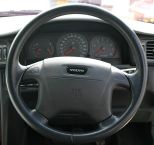AT&T To Reinvent GPS Guidance With Haptic Steering Wheel
 GPS has all but done away with the physical map, and pre-trip planning for that matter. While GPS screens are less dangerous to look at than, say, a full-sized map, they still take your eyes away from the road, and that perceived ease of the glance probably discourages people from letting their copilot navigate, as they might otherwise. All that said, GPS probably contributes to more on-road distraction than you might think. Some are aiming to turn the windshield into a screen, but AT&T Labs is trying to change up the whole game by eliminating the screen entirely and relying instead on a haptic steering wheel.
GPS has all but done away with the physical map, and pre-trip planning for that matter. While GPS screens are less dangerous to look at than, say, a full-sized map, they still take your eyes away from the road, and that perceived ease of the glance probably discourages people from letting their copilot navigate, as they might otherwise. All that said, GPS probably contributes to more on-road distraction than you might think. Some are aiming to turn the windshield into a screen, but AT&T Labs is trying to change up the whole game by eliminating the screen entirely and relying instead on a haptic steering wheel.
The haptic wheel works by providing vibrations — not force-feedback — along the outer edge of the wheel. The 20 points of vibration allow for a variety of different patterns with different intensities, but the two important ones are vibration in a clockwise pattern prompting a right turn, and in a counterclockwise pattern a left turn. Right now, the brunt of the development energy is being spent on figuring out the best way to deliver these directions, but there’s also some thought being given about using vibrations to warn drivers of cars in their blind spots and other noteworthy things.
During testing, the haptic steering wheel prototype seems to be doing a good job, with younger drivers at least. When given to drivers with an average age of around 25, the haptic steering wheel was able to reduce inattentiveness to 3.1%, inattentiveness being the amount of time during which drivers were looking at something other than the road.
When it comes to drivers around the age of 65, however, the haptic feedback did almost nothing. Probably because they can remember a time when the vast majority of one’s personal belongings didn’t occasionally vibrate. Older drivers did benefit from audio-only directions, which dropped their inattentiveness down to around 4%.
AT&T is working on a paper based on the conclusions from this research, which will be released later this year. So far, however, the findings seem significant. Considering that there are an ever increasing number of laws against texting and driving — which is admittedly more dangerous — why not be more proactive about other things which take eyes off the road, especially GPS which is pretty explicitly designed for use while driving. Haptic steering wheels seem like an interesting solution to the problem, but this will all become a non-issue with the hopefully imminent spread of self-driving cars. Fingers crossed.
(via Technology Review, image credit SamH)
- Mercedes-Benz is bringing Siri to its cars
- Teslas can be permanently bricked if they reach 0% charge
- Video from one of Google’s self-driving cars
Have a tip we should know? [email protected]